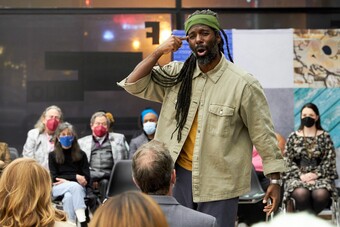A Play About a Neighborhood
Community and New Play Development in The Duchess of Stringtown
What happens when you mix local history, a women’s prison, and new play development?
In 2015, Bryan Fonseca, producing director at the Phoenix Theatre of Indianapolis, was awarded a two-year Transformational Impact Fellowship from the Arts Council of Indianapolis to help revitalize the Near Westside of Indianapolis. The fellowship supported the development of Discover Near West Indys, a separate initiative focusing on arts education and community events in the Near West neighborhoods. Comprised of four neighborhoods (Haughville, Hawthorne, We Care, and Stringtown), the Near West has always been one of the most diverse areas in Indianapolis. The fellowship is intended to use the arts to spur civic engagement and economic development in historically underserved areas of the city. As part of the Discover Near West Indys initiative, the Phoenix has spent the past nine months developing The Duchess of Stringtown which culminated in a full production this past December.
Stringtown is geographically the smallest neighborhood and has one of the least active neighborhood associations. It is primarily a residential area along the White River, immediately next to the Indianapolis Zoo. Searching for a way to connect to this neighborhood, a project happening eight miles outside of Stringtown at the Indiana Women’s Prison was brought to Fonseca’s attention. Two of the inmates, Michelle Jones and Anastazia Schmid, had been doing extensive research into the origins of the Indiana Women’s Prison and had turned their findings into a play.
The script by Jones and Schmid was inspired by an 1872 newspaper article that provided a detailed and sensational account of the funeral for Joanna Kitchen, better known simply as the Duchess of Stringtown, a local madame, who had an ongoing feud with Smith.
Kelsey Kauffman, a former volunteer for the prison’s education program, had been helping to guide the project and had begun advocating for someone in the local theatre community to get involved. Kelsey approached Gigi Jennewein, a theatre professor at DePauw University, and Bryan Fonseca about the project and a match was made. Jennewein directed a production of the original script at the women's prison. Twenty-five inmates signed on to act and help manage the show. The first thought was to produce the entire script, but it quickly became clear that would not be possible in the allotted time, so roughly six or seven scenes were selected. The first performance was in April 2017 for the National Council on Public History Conference and a second performance was staged a week later for the general prison population and invited guests. Fonseca and Jennewein knew immediately from this process that the play needed to get into the community because of the intriguing local history and artistic potential of the script. With the support of the Transformational Impact Fellowship, we introduced playwright Toni Press-Coffman to the project and got her on board to begin the workshop process.
Jones and Schmid are, without a doubt, incredible historians. They were able to trace the history of the prison back to a women’s reformatory founded by Sarah Smith in 1873 called the Home for Friendless Women. The script by Jones and Schmid was inspired by an 1872 newspaper article that provided a detailed and sensational account of the funeral for Joanna Kitchen, better known simply as the Duchess of Stringtown, a local madame, who had an ongoing feud with Smith. The Duchess owned a local brothel that would prove an impediment to the future annexation of Stringtown into the city of Indianapolis. The annexation would not officially occur until 1897, but the local politics and corruption are key pieces of the story. More importantly, the play centers on a conflict between the Duchess and Sarah Smith over what was to become of the young women in their care as a result of these larger changes.
As you can imagine, navigating the visions of three playwrights had its challenges and the logistics involved in any new play production process, it would have been only too easy to forget about these goals and how the play fit into the Near West community. Amidst a flurry of Letters of Agreement and notes and meetings, we inadvertently developed a strategy for staying grounded on the project as we moved forward in the process.

The first, and most obvious decision, was to produce the show on the Near Westside. The first staged reading was open to the community, free of charge, at Indy Convergence, our community partner on the Near Westside. Indy Convergence is a fantastic community arts center located in Haughville and easily accessible to the other three neighborhoods. Since Indy Convergence put down roots on the Near Westside in 2015, they have become a neighborhood fixture and have done incredible work bringing artists and programming to the community. We have successfully partnered with them on several of our outreach programs over the past two years and staging Duchess there was a no-brainer.
By partnering with Indy Convergence and bringing the show directly to the Near West community, we overcame some major obstacles. While the Phoenix prides itself on providing our patrons with a comfortable and inclusive theatre-going experience and we do everything we can to communicate these values, the idea of going into downtown to attend a professional production still may seem irrelevant or unwelcoming to many Near West residents. Bringing the show to their own backyard makes the idea of seeing a professional play more approachable and accessible. Additionally, there are inevitable barriers in marketing and promotion that the change of venue allows us to overcome. With all of our outreach programming, having this direct connection makes getting an ad up at the neighborhood association or approaching local businesses easier.
There were two other obvious things we had to do as we began planning for a full production. First, we had to focus on local talent. All of our actors for Duchess of Stringtown are from Indianapolis and everyone on our production team is either based in or has done previous work in Indianapolis. By working with artists we knew had a strong connection to the city, we ensured they would have some understanding of the Near West neighborhoods and that they would have a stronger investment in the project. Indianapolis is not a particularly large theatre market, not by a long shot. As a result, a lot of our local talent is rooted in the community beyond just living here to work. Many of them grew up in Indiana. Many of them have family in-state who regularly participate in the theatre scene. They have spouses and children and homes, having made a significant commitment to community in their personal lives. This is by no means a unique context in regional theatre, but has nevertheless helped to shape and strengthen our programming.

Of course, as with all community performances, our second requirement was to minimize ticket costs. It was never a question whether performances would be free to Near West residents. With the support from the Arts Council, we were able to make this decision without a second thought. Our goal with producing Duchess of Stringtown became simply to further develop the script and stage the best production. This is not a luxury afforded to the majority of community projects, and it was important to us that we take this incredible opportunity to truly commit to our goals and focus on engaging the community.
All of the planning and script development culminated in two performances, 22 and 23 December 2017. Initially, the plan was to only seat fifty. After a New York Times article about Jones edged this project into the local spotlight, however, we ended up with seventy-four people in the audience our first night and a sold-out house of eighty people the second night. At this time, we have no plans to remount the production, but we have no doubt that we could have filled the house for a second weekend.
The primary objective for the production was that it remain uniquely accessible to the Near West community and, we hope, shed some light on the diverse and complex history of Stringtown and the Near Westside.
One of our objectives from the very beginning was to organize a post-show discussion to dissect the local history and the creative process that went into this play. The first performance was followed by an incredible talkback with author Michelle Jones and director Gigi Jennewein. The conversation stayed focused on the development of the script, Jennewein and Jones’s experiences working together, and the research Jones and Schmid had put in to the script. There was also a presentation by the local chapter of the National Council of Negro Women. Jones had worked with these women as part of the prison’s education program.
The production process for The Duchess of Stringtown involved many people's hard work and vision, straddling the line between commercial production and community engagement. As we have moved through the process, the primary objective for the production was that it remain uniquely accessible to the Near West community and, we hope, shed some light on the diverse and complex history of Stringtown and the Near Westside. Post production, Discover Near West Indys has been working with Indiana University-Purdue University Indianapolis to evaluate not just this production, but all of Discover Near West Indys’ programming over these past two years. This is the third full production brought to the Near Westside through Discover Near West Indys in addition to a variety of education and community programs, which the Phoenix will continue to support and grow. While the evaluation is still in progress, it is already clear that this experiment has far exceeded the initial goals of the Transformational Impact Fellowship and we, along with our community partners, will find more projects that showcase the Near West’s unique role in the larger Indianapolis community.












Comments
The article is just the start of the conversation—we want to know what you think about this subject, too! HowlRound is a space for knowledge-sharing, and we welcome spirited, thoughtful, and on-topic dialogue. Find our full comments policy here
Terrific. Theatre connecting communities within community, connecting local history with local present. Most heartening!